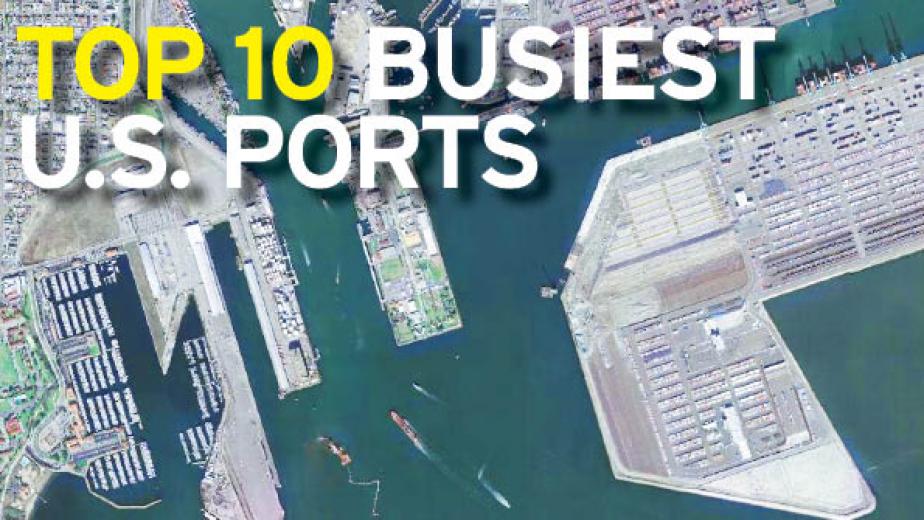1 11
1 11
Port Everglades is "Florida's best-kept secret," reports Colliers, "with the most TEU container traffic and unheralded expanding trade relationships" with Latin American countries. Port Everglades moved 1 million TEUs in 2013. A dredging application is currently under way, but the port will not be PPMX ready by 2015.
The Port of Tacoma is strongly competitive and giving Seattle a run for its money; currently, Tacoma ranks as having the best TEU growth percentage among West Coast ports. As such, Colliers has named it a member of its "1 Million TEU Club" for four straight quarters over 1 million TEUs. Tacoma became PPMX ready in 2011 with its gantry crane upgrades, and is succeeding where Oakland, Portland and Seattle are not.
The Port of Charleston will "duel it out" with Savannah along the banks of the Savannah River for status as the East Coast's Long Beach, reports Colliers. Charleston will complete its PPMX-readiness dredging to 50 ft. in 2018-2019. The port moved 1.55 million TEUs in 2013. Charleston has a natural ocean harbor without limitations associated with river ports and its new inland port in Greer, S.C., will likely give Charleston the edge over Savannah in the coming decade, provided Charleston can complete its PPMX readiness in time.
The Port of Oakland occupies 19 miles of waterfront on the eastern shore of San Francisco Bay with 665 acres devoted to maritime activities. Oakland is PPMX ready and is in the process of a $1.2 billion upgrade, including building a world-class Global Trade & Logistics Center; new roads, utility infrastructure, rail manifest, support rail yard, bulk marine terminal and recycling center; environmental remediation and 1 million sq. ft. of new warehouse space. Oakland moved 1.6 million TEUs in 2013.
The Port of Houston is vital to U.S. energy interests and is highly profitable too. In the past, Colliers has recognized Houston as North America's Most Irreplaceable Port, but this year Colliers has awarded Houston with the GDP Award, or "Gulf's Darn Profitable" Award. Houston wins for its "incredible profitability in 2013," having generated $21 million in operating revenue last July, a 7 percent increase over the same period in 2012. Houston is currently dredging for PPMX readiness, as well as upgrading cranes, and topped the list of Gulf Coast ports (the other three are New Orleans; Mobile, Ala., and Tampa, Fla.) at 2.1 million TEUs moved in 2013. Houston expended $220 million in 2013, rising to $300 million in 2014 with a new $60 million order for Super-PPMX gantry cranes. Houston's master plan is to expend $3 billion on CapEx through 2025.
The Port of Virginia in Norfolk, Va., is the East Coast's original deepwater port and was the first East Coast port to be PPMX ready. Last year, Norfolk moved 2.3 million TEUs. The port has no physical, port leadership or business strategy deficiencies, and emerged with several winning PPMX strategies in 2013, marking it as an up-and-coming port.
Seattle is already PPMX ready and is increasing its competition with Port Rupert in British Columbia, Canada. In 2013, Seattle moved 3 million TEUs. But Seattle is fast losing out to Tacoma, which was the West Coast port with the fastest container traffic growth rate year to date in 2013.
The Port of Savannah has acquired Super PPMX cranes and is currently dredging to 47 ft., but will not be PPMX ready by 2015. Nonetheless, Savannah was the third-busiest U.S. port in 2013, moving 3.1 million TEUs. In direct competition with Charleston, S.C., Savannah has an advantage in logistics and agricultural exports, and the Georgia Ports Authority has shown that "it can achieve more with less over time," Colliers reports. The Port of Savannah is currently the fourth-busiest container port with the shallowest channel depth among the eight deepest and busiest container ports in North America.
New York is struggling with its PPMX-readiness program, with New Jersey's Bayonne Bridge currently being raised at the expense of hiring retiring dock workers, upgrading software, etc. New York's residual labor and Hurricane Sandy issues "are resulting in unprecedented shipper complaints and redirection of cargo business" to other East Coast ports, especially Virginia, or even the Great Lakes ports, according to Colliers. Cleveland's new express route to Europe is also shifting cargo away from New York, which moved 5.5 million TEUs in 2013.
Los Angeles and Long Beach ports are both 100 percent PPMX ready, but leadership of the two ports remains in question. In 2013, the two ports combined moved 14,000 TEUs (thousands). The two ports combined are spending approximately $5 billion on port infrastructure upgrades from 2012 to 2017. According to Colliers, "the Southern California ports see the Panama Canal as a big deal, and intend to surrender nothing to East Coast ports."

